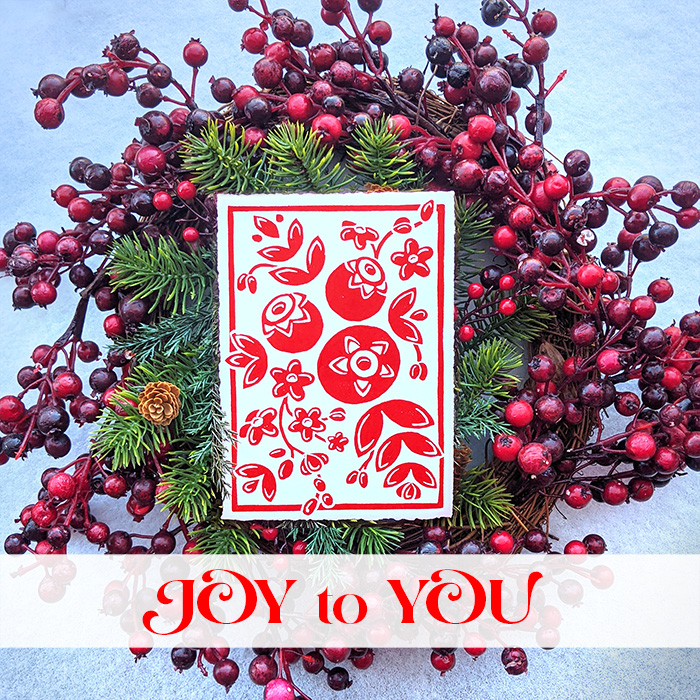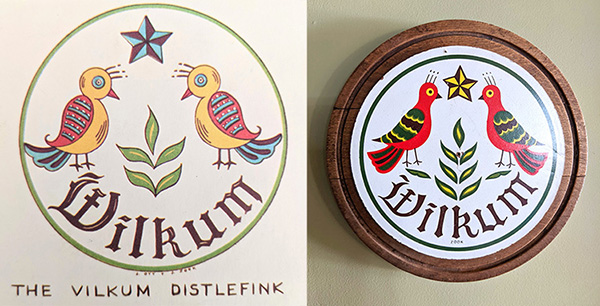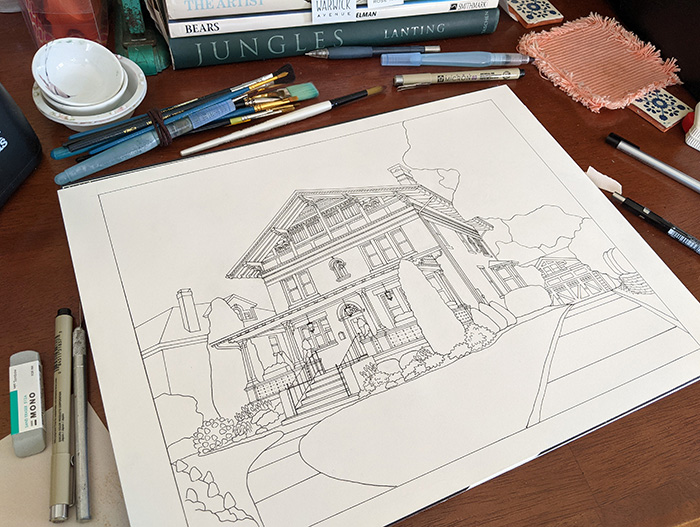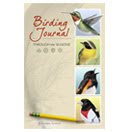"What will come from the briar but the berry." — Irish Proverb
●●●●●
●●●●●
Willy Wonka: The strawberries taste like strawberries. The snozzberries taste like snozzberries!
Veruca Salt: Snozzberries? Who ever heard of a snozzberry?
[Wonka grabs Veruca's jaw]
Willy Wonka: We are the music makers... and we are the dreamers of dreams.
— Roald Dahl, Charlie and the Chocolate Factory
●●●●●
INSPIRATION
I told myself last year I wasn't going to do a Christmas card this year unless I had purchased a press. Well, I didn't have a press come late November and I had to decide whether or not to do it. I looked through my designs from years past and the alternate designs that never came to fruition. The only one that appealed to me was a two-color idea, but I knew with the high quantity it would be too much. So I decided to let it go a few days and see if any one-color ideas came to me.
“There’s no earthly way of knowing which direction we are going.” — Willy Wonka
A couple days later I was coming in from the back porch and I spied a vintage tray that I bought a few years ago from my friend Sarah. It was super faded, but the idea came that I should do a simple, red and white folk floral design.
SKETCH, ILLUSTRATOR, TRANSFER
I began with a quick pencil sketch. I don't always re-draw my sketches in Illustrator, but I knew this sketch needed a bit more work. Below you can see how I altered the sketch once I traced it in Illustrator.
In the past if I began with a computer printout, I have simply scribbled the back with pencil and traced the design to transfer to the block. But I figured there had to be a more precise way. So I watched several YouTube videos about how to transfer a laser printout using acetone. In the video I watched, the person used a black printout. However, I had already printed my design in red and I was antsy to try it.
“Stop. Don’t. Come back.” — Willy Wonka
I forged ahead using my red printout and after rubbing the back of my paper with the acetone I was sure the experiment had failed. The paper was shredding and at first, it didn't seem like the design transferred.
But after a little more rubbing I could still see a faint yellow outline of my design.
“Invention is 93% perspiration 6% inspiration 3% perspiration and 2% butter scotch ripple.”
— Willy Wonka
The whole right side didn't transfer so I re-drew that part on the plate. As you can see above, I used a ruler to recreate the right border, eye-balling it the best I could.— Willy Wonka
Once I finished carving, I again used acetone to clean the plate of the remaining ink.
This video shows the entire process set to Jingle Bells (Music by ZakharValaha from Pixabay).
TEARING PAPER
My Christmas list has grown quite a bit over the years and I knew I needed at least 136 cards. I bought my favorite Stonehenge paper and each sheet gave me 18, so I tore 8 sheets. People always ask why I tear the paper instead of cutting it and it is because printmaking paper gives a beautiful deckled edge when torn. It took me about 3 1/2 hours to tear the paper down to size (probably would have taken me the same amount of time to cut it).
PRINTING
“When the time comes for you to make a change or to grow,
the universe will make you so uncomfortable you will eventually have no choice.”
the universe will make you so uncomfortable you will eventually have no choice.”
— Iyanla Vanzant
I normally would never tear paper the same day of printing because it is simply too much. But I was worried about having time for the prints to dry after my never-drying "Pigsqueak" experience this summer. So after dinner I went down to pull a test print. (Music by Lesfm from Pixabay)
It makes me laugh watching the video now because it seems so idyllic and cheery. Nothing could have been further from the truth that night. That is because I spent a lot of time meticulously measuring 1/4 inch out from the plate and carefully marking it so I would know where to place the paper. When I put my test paper down, the plate barely fit on my perfectly-torn paper! How could this happen, you ask, when I did an acetone transfer? Well, remember when I said the right half of the transfer didn't work so I just eye-balled it? I guess I didn't eye-ball it square and the plate ended up skewed.
Needless to say I wasn't very happy about it. In fact, I had a mini-meltdown and was ready to throw the towel in. I tried stretching the plate. In desperation I grabbed a pair of scissors and frantically cut a jaggedy hole around the plate so I could tape the plate directly to the table to compensate for the skew.
It makes me laugh watching the video now because it seems so idyllic and cheery. Nothing could have been further from the truth that night. That is because I spent a lot of time meticulously measuring 1/4 inch out from the plate and carefully marking it so I would know where to place the paper. When I put my test paper down, the plate barely fit on my perfectly-torn paper! How could this happen, you ask, when I did an acetone transfer? Well, remember when I said the right half of the transfer didn't work so I just eye-balled it? I guess I didn't eye-ball it square and the plate ended up skewed.
"What is this, a freak out?"
— Violet Beauregarde
Needless to say I wasn't very happy about it. In fact, I had a mini-meltdown and was ready to throw the towel in. I tried stretching the plate. In desperation I grabbed a pair of scissors and frantically cut a jaggedy hole around the plate so I could tape the plate directly to the table to compensate for the skew.
“Well, fortunately, small boys are extremely springy and elastic.
So I think we’ll put him in my special taffy-pulling machine.
That should do the trick.”
— Willy Wonka
So I think we’ll put him in my special taffy-pulling machine.
That should do the trick.”
— Willy Wonka
This did not work. Tape is no solution for a skewed plate. In the end I glumly recognized the only way to proceed was to have perfect registration on every single print.
To help me register the paper, I used a piece of wood taped to the table. Because of the skew, the right side had to be higher than the left. I quickly realized the blue tape allowed my wood guide to move too much. Plus, in order to apply enough ink at the bottom of the plate, I had to move the wood away every time. In the end I left it attached on the right side and flipped it away for inking. I then flipped it back for placing paper, using the edge of the plate as a guide. I just had to concentrate really hard every time to place the wood and paper very slightly higher on the right.
“Impossible, my dear lady! That’s absurd! Unthinkable!”
— Willy Wonka
— Willy Wonka
To help me register the paper, I used a piece of wood taped to the table. Because of the skew, the right side had to be higher than the left. I quickly realized the blue tape allowed my wood guide to move too much. Plus, in order to apply enough ink at the bottom of the plate, I had to move the wood away every time. In the end I left it attached on the right side and flipped it away for inking. I then flipped it back for placing paper, using the edge of the plate as a guide. I just had to concentrate really hard every time to place the wood and paper very slightly higher on the right.
“No other factory in the world mixes its chocolate by waterfall…
But it’s the only way if you want it just right.”
— Willy Wonka
But it’s the only way if you want it just right.”
— Willy Wonka
It actually worked surprisingly well until about 80 prints in when I started printing off the edge. The plate, which was double-sided-taped to the table, had slowly moved to the right from all the burnishing. I adjusted my technique and we were back in business. I probably only lost a handful to printing off the edge.
In addition to my skewed plate woes, the plate kept giving me fuzzy edges. For two days we had fuzzy-edged prints. It is really disheartening to put your all into something and not get the results you would like. I finally had the idea to stop using the baren and only use the wooden spoon (instead of both). It helped. Sometimes it takes time to figure out the best way to print a plate.
Violet Beauregarde: I'm a gum chewer mostly, but when I heard about these ticket things, I laid off the gum; switched to candy bars.
DRYING
“I don’t understand it. The children are disappearing like rabbits.
Well, we still have each other. Shall we press on?”
— Willy Wonka
Well, we still have each other. Shall we press on?”
— Willy Wonka
In addition to my skewed plate woes, the plate kept giving me fuzzy edges. For two days we had fuzzy-edged prints. It is really disheartening to put your all into something and not get the results you would like. I finally had the idea to stop using the baren and only use the wooden spoon (instead of both). It helped. Sometimes it takes time to figure out the best way to print a plate.
We printed for three hours every day for five days. I usually like to power through to save on clean-up, but I was physically spent after each printing session. In the end, it took us 15 hours to print 154 prints (I tore some extra paper). That's almost 6 minutes per print.
“A jug fills drop by drop.” – Buddha
Violet Beauregarde: I'm a gum chewer mostly, but when I heard about these ticket things, I laid off the gum; switched to candy bars.
Mrs. Beauregarde: She's just a driven young women. I don't know where she gets it.
After a week of drying in the basement I thought the prints were dry because I added a cobalt siccative. So, if you receive one of these prints, please do not lick them (this is NOT lickable wallpaper); it is bad for you to ingest!
I stacked the best twenty prints and brought them upstairs to sign and number. When I unstacked them, I realized the prints weren't quite dry because many of them printed themselves onto the backs of the print above. It was an extremely stressful moment as I realized I might have ruined twenty prints! After carefully unstacking them I found the tops were not smudged. I felt extremely lucky that none of them were ruined. I was hoping not to have to do this, but I brought all the prints up from the basement and placed them around the house on the radiators. It is always a risk to carry wet prints through a house of cats and cat hair.
I can tell when a project is pushing me to my limits because I stop taking photos. I normally would have taken a photo of the touching-up, numbering and signing, but I was starting to feel desperate to finish. It took me two days to do this part.
ADDRESSING
Some times I need a break from the printing part of the process, so I procrastinate by designing custom stickers. This year I made a matching berry return label and berry joy sticker for the back. Each letter received four stickers: a custom berry return address, an address, a stamp, and a berry joy stamp.
In years past, magical elf (and husband) George helped with the addressing and label-sticking part of the project. But this year he was only able to help do the return addresses because he went to Costa Rica to visit the jungle gnomes (smart man!).
I stacked the best twenty prints and brought them upstairs to sign and number. When I unstacked them, I realized the prints weren't quite dry because many of them printed themselves onto the backs of the print above. It was an extremely stressful moment as I realized I might have ruined twenty prints! After carefully unstacking them I found the tops were not smudged. I felt extremely lucky that none of them were ruined. I was hoping not to have to do this, but I brought all the prints up from the basement and placed them around the house on the radiators. It is always a risk to carry wet prints through a house of cats and cat hair.
"Cat hair is my glitter" – Unknown
“Hm… well, I think that furnace is only lit every other day,
so they have a good sporting chance, haven’t they?”
— Willy Wonka
so they have a good sporting chance, haven’t they?”
— Willy Wonka
I can tell when a project is pushing me to my limits because I stop taking photos. I normally would have taken a photo of the touching-up, numbering and signing, but I was starting to feel desperate to finish. It took me two days to do this part.
ADDRESSING
Some times I need a break from the printing part of the process, so I procrastinate by designing custom stickers. This year I made a matching berry return label and berry joy sticker for the back. Each letter received four stickers: a custom berry return address, an address, a stamp, and a berry joy stamp.
In years past, magical elf (and husband) George helped with the addressing and label-sticking part of the project. But this year he was only able to help do the return addresses because he went to Costa Rica to visit the jungle gnomes (smart man!).
“Of course they're real people. They're Oompa-Loompas...Imported direct from Loompaland...And oh what a terrible country it is! Nothing but thick jungles infested by the most dangerous beasts in the world - hornswogglers and snozzwangers and those terrible wicked whangdoodles. A whangdoodle would eat ten Oompa-Loompas for breakfast and come galloping back for a second helping.” — Willy Wonka
POEM
The past couple years we have been including a poem with each card. This year's included a sliver of my bedroom "pandemic" sketch (you can read more about that here).
CONCLUSION
CONCLUSION
It happens every time, they all become blueberries. —Willy Wonka
In case you missed it in the poem, I decided this was the last year to send hand-printed cards. It may not have helped to be writing the poem after long, difficult days of printing. But I had been on the verge of that decision before even starting the cards this year.
I am not one who easily embraces change. One time our neighbor came over and re-arranged the furniture (he is very skilled at it!). I could hardly stand it a day before I had to move it right back. Sometimes I think we need to be very uncomfortable before we make changes... and this year the universe made printing the cards excruciating.
I know there are a variety of ways I could make it easier. I could shorten our list and make fewer cards. I could get a press. I could make a few prints and then send digital copies of the print (or make digital prints to begin with). I could also take a break from Christmas cards. I want to make choices for myself that are filled with more joy and less self-flagellation. I know that sounds obvious, but my actions speak for themselves. Somehow all my projects "turn into blueberries." They become giant and need to be rolled into the juicing room to be squeezed. (And I've twisted myself into a pretzel shape and turned blue by the end.) I don't know what will happen next year, but I do know for sure that something needs to change. Sometimes that is where we have to start... just recognizing the simple desire for change.
The other thing I know for sure is that I love spreading joy. I like to envision each person who receives this card smiling when they see the joy sticker on the back, delighting in their handmade print, and chuckling when they read the poem. It is my hope the future holds joy for you and joy for me. I wish each and every one of you a holiday filled with snozzberry pie. And I was going to say, "I hope we can all give up chewing gum for chocolate to find our golden tickets in the New Year." But perhaps the better analogy would be to say I hope we spend our precious energy on buying one "scrumdiddlyumptious bar" for ourselves and one for Grandpa Jo. May your New Year be filled with peace and may you live in happiness too... like the Oompa-Loopa doopadee do!
I am not one who easily embraces change. One time our neighbor came over and re-arranged the furniture (he is very skilled at it!). I could hardly stand it a day before I had to move it right back. Sometimes I think we need to be very uncomfortable before we make changes... and this year the universe made printing the cards excruciating.
I know there are a variety of ways I could make it easier. I could shorten our list and make fewer cards. I could get a press. I could make a few prints and then send digital copies of the print (or make digital prints to begin with). I could also take a break from Christmas cards. I want to make choices for myself that are filled with more joy and less self-flagellation. I know that sounds obvious, but my actions speak for themselves. Somehow all my projects "turn into blueberries." They become giant and need to be rolled into the juicing room to be squeezed. (And I've twisted myself into a pretzel shape and turned blue by the end.) I don't know what will happen next year, but I do know for sure that something needs to change. Sometimes that is where we have to start... just recognizing the simple desire for change.
“If your compassion does not include yourself, it is incomplete.” – Buddha
Willy Wonka: [to Oompa Loompa] I want you to roll Miss Beauregarde into the boat and take her along to the Juicing Room at once. Okay?
Mrs. Beauregarde: The Juicing Room? What are they gonna do to her there?
Willy Wonka: Oh, they're gonna squeeze her. Like a little pimple. We've gotta squeeze all that juice out of her immediately.
[Mrs. Beauregarde gasps]
[Mrs. Beauregarde runs up to Blueberry Violet, who is stuck in the door]
Blueberry Violet: Mother, help me. Please!
[Mrs. Beauregarde helps Oompa Loompas push Blueberry Violet through door]
Violet Beauregarde: [after stretching into a pretzel shape] Look mother, I'm much more flexible now.
Mrs. Beauregarde: [disapprovingly] Yes, but you're blue.
— Roald Dahl, Charlie and the Chocolate Factory
— Roald Dahl, Charlie and the Chocolate Factory


























































